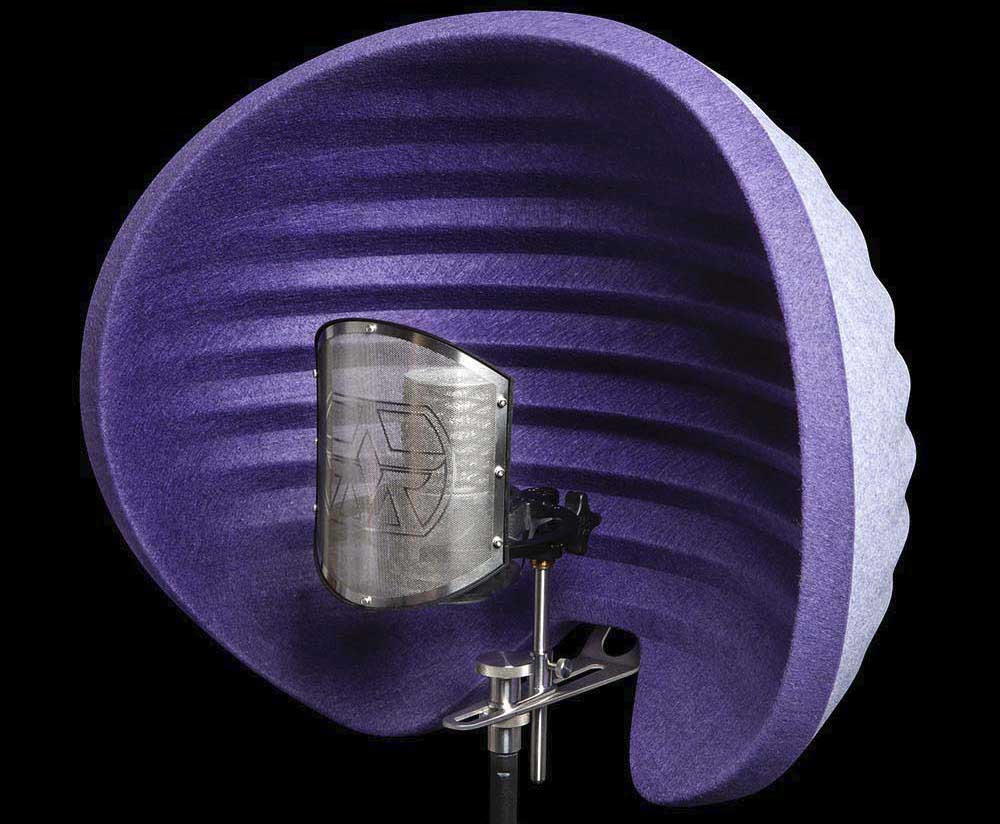Aston Microphones is a young British company founded in 2015. They burst onto the market with the Origin large diaphragm condenser — a stylish and very original looking transducer, recognized by its brushed metal body and wire mesh grill. Over the last several years, they’ve expanded their lineup to include additional microphones and accessories. The Halo is Aston’s riff on the popular reflection filter. In this Aston Microphones Halo reflection filter review, we’ll uncover whether this uniquely designed shield is amongst the best in its class.
What Is a Reflection Filter & What Does It Do?
A reflection filter minimizes the “liveness” of a recording space. In theory, they’re built to make an untreated or lightly treated room a decent recording environment with little unwanted reflections. You can think of them as “drying up” a lively room for cleaner vocal takes with less room tone.
Reflection filters are an accessory that attaches to the microphone stand behind the mic. Different companies use different materials and designs, but the purpose is always the same.
How Does a Reflection Filter Work?
Reflection filters like the Aston Halo use a variety of absorptive acoustic materials to stop reflections. The shield completely covers the backside of the mic and wraps around its sides as well. The filter rejects frequencies bouncing around the room from entering the back or side of the mic.
And as a vocalist projects into the microphone, and into the shield, the filter absorbs that head-on acoustic energy, too. That’s so those frequencies can’t reflect off of a wall and back over the vocalist’s shoulder, on-axis, straight into the microphone. We’d always recommend placing an absorber of some kind behind your vocalist though, especially if you’re working in a really poor sounding room. That’ll just help mop up anything the reflection filter lets slide.
Aston Microphones Halo Reflection Filter Review
The Aston Halo Is a Unique as They Come
Not surprisingly, the Halo mic shield has a totally imaginative appearance. It doesn’t resemble any other filter currently on the market. The Halo is sort of a half-sphere shape with multiple ridges on the inside, and it comes in either the original purple or black PET felt. The felt is some of the world’s most lightweight and efficient acoustic materials.
How Big Is It?
The Aston Halo is relatively large, measuring approximately 12″ deep and nearly 21″ wide. It’s bigger than many other filters on the market, but it remains light at just four pounds thanks to the materials Aston constructed it from. Still, it doesn’t fold or wad up in any way, so unless you have it permanently fixed to a mic stand, you’ll need a bit of room to store it when not in use.
Is It Easy to Use?
The Halo reflection filter is as easy to use as mounting it to your mic stand with the included stainless-steel hardware. Once you’ve set up, you’re ready to record.
How Does the Aston Halo Reflection Filter Sound?
Overall, the Aston Halo is an impressive reflection filter. We especially love how it encompasses both the top and bottom of the microphone as well to reduce floor and ceiling reflections. Even though it isn’t the first filter to consider floor/ceiling, it’s able to reject those reflections in a more transparent way. Compared to something like the Kaotica Eyeball, for example, the Halo is natural sounding with no obvious coloration. This is good, because it’s not necessarily beneficial to trade one type of unwanted coloration for another — particularly when you’re shelling out big bucks like this.
Our Take: Is It Worth the High Price Tag?
Considering the specific use of these types of accessories, the price is justified. In other words, if you’re even considering a reflection filter, you probably have some acoustic issues you’re trying to solve. With that in mind, the Halo is a premium, lightweight, effective shield which will help clean up room tone in your recordings.
